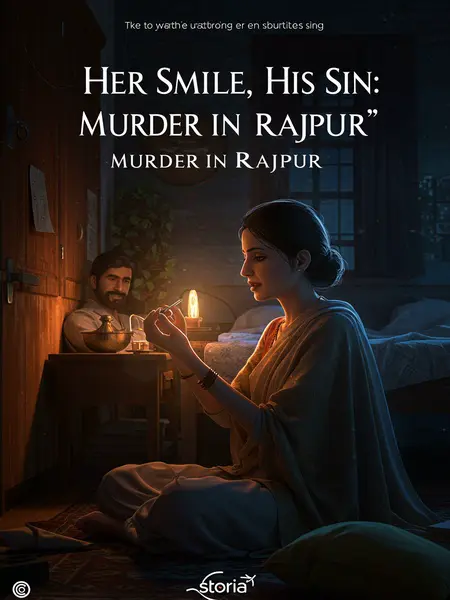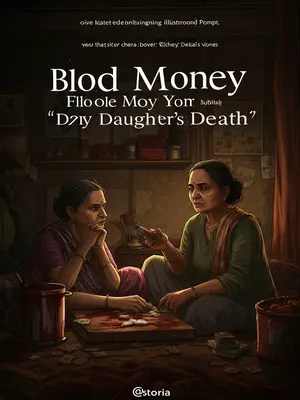Chapter 1: The Muskurahat Mystery
Kisi bhi aadmi ki kitni bhi mazboot himmat ho, ek muskurati aurat ke jaadu se bachna mushkil hai," someone whispered at the chai tapri outside Rajpur police station. The words hung in the morning air, thick with the scent of cutting chai and city dust.
An old constable, wiping sweat from his brow, muttered under his breath, "Chaar log milkar bhi aurat ki muskurahat ka samna nahi kar sakte, yaar." The others chuckled, but the truth lingered—no matter how much a man controls his heart or mind, ek aurat ki muskurahat ya ada ka jaadu se koi nahi bach sakta. Sometimes, the heart is more gullible than the mind will ever admit, hai na?
The Maharashtra murder case of 2010, later famous in every criminal investigation textbook, is a perfect example of this.
Back then, the story of this case didn’t just echo through police stations—it travelled through every chai tapri and mohalla. In homes across Rajpur, families debated crime and justice over evening chai and Parle-G, making the case a household legend.
On 26th October 2010, a call reached Rajpur police station: a man reported a burglary at his house.
Outside, leftover crackers popped now and then, and the air was thick with the smell of burnt ghee from yesterday’s diyas. Inside the police station, the wall clock ticked loudly above the inspector's desk, its glass face smeared with last year’s rangoli dust. The phones kept ringing; this call seemed routine—until it wasn’t.
Initially, officers assumed another routine theft and dispatched a team.
A constable, cursing his missed vada pav, bounced in the back of the patrol jeep as they rattled over potholes. No one expected more than a new entry in the theft register.
But inside the house, the officers found a young woman hidden in the owner’s wardrobe.
The musty wooden wardrobe, tinged with mothballs and old talcum powder, looked undisturbed. As the doors creaked open, a constable hesitated, his torch slipping from his grasp. Silence filled the room before a gasp broke it—there she was, crumpled, eerily still.
Her nightgown was torn at the shoulder, the fabric bunched awkwardly, revealing bruises on her arm.
She looked as if she’d been hastily shoved inside—hair dishevelled, bruises blooming across her fair arms, a gold bangle twisted around her wrist. Her dupatta was missing, a thin silver chain tangled at her throat.
Her eyes were tightly shut, a large bloodstain spreading across the back of her head.
One constable dropped his torch, muttering a prayer as he looked away. The blood had seeped into the soft cotton of her nightgown, staining the wardrobe floor. A faint scent of sandalwood clung to her hair, mingled with the metallic tang of blood.
The caller, Rohan Tiwari, stood trembling in the hallway, his feet bare, a broken chappal lying near the doorway. As Inspector Amit entered, Rohan pressed his palms together in a nervous namaste, his voice barely a whisper: "Meri Ananya... meri Ananya..." The world seemed to have collapsed around him, his hands wringing the edge of his kurta.
The police confirmed Ananya had been dead for some time; rigor mortis had already set in. After a heavy silence, a neighbour’s voice floated in from the corridor: "Hai Ram, yeh kya ho gaya?" The shock rippled through the building.
Inspector Amit himself checked her pulse, then quietly signalled for the junior constables to cover her with a faded bedsheet. The room fell silent, broken only by the distant hum of a ceiling fan and Rohan’s muffled sobs.
With the case now clearly a homicide, the district crime branch’s investigation team arrived, dust swirling in the lane as their jeep pulled up.
Aunty from the first floor peered through her window grill, clutching her dupatta and whispering for her son to get off the balcony. Neighbours whispered prayers or dialled relatives as the officers moved in with grave urgency.
Inspector Amit Verma, with over a decade of frontline experience, led the team. He adjusted his Ray-Ban sunglasses on his forehead—a habit from years in the field—and scribbled quick notes in his battered red notebook. He was known for his patience and memory; some called him 'Chatur Amit' behind his back.
The moment Amit entered, he sensed something was off. He didn’t just look—he observed. Taking a slow breath, he scanned the room: misplaced slippers, scattered magazines, a half-burnt agarbatti in the corner, its scent barely masking the harsh tang of cleaning fluid. The floor shone suspiciously, as if freshly wiped with phenyl.
Drawers were yanked open, sarees flung carelessly, even the tin of Britannia biscuits lay open and empty. Yet, in the middle of this chaos, the floor was too clean. Amit knelt, touching the tiles—still damp, the sharp smell of Lizol in the air. "Sir, yahan kuch gadbad lag raha hai," he muttered.
Would a thief really stay after a murder to clean? In India, thieves run—Amit had seen them leave behind loot, even shoes. Panic leaves a mess, not spotless floors. "Arrey, who cleans after committing murder?" he wondered aloud.
If a thief breaks in and is caught, he flees—leaving half the loot, tools, even a slipper behind. No one takes time to mop up after murder.













